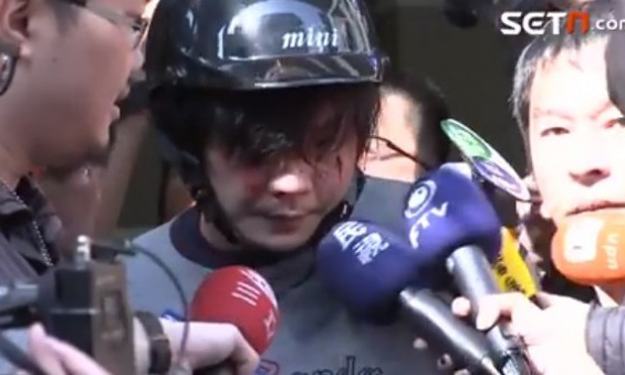Agenda Setting by Taiwanese Mass Media In the Case of the Recent Child Killing Incident
by Tumin
語言:
English /// 中文
Photo Credit: SET
THE RECENT murder case of a four year old girl in Taiwan has brought the capital punishment debate back on stage. It seems that such ethical debates only seem to appear in the case of “shocking” news that provides opportunities for sensationalist journalism. As mass media rides the wave of clickbait streaming into their sites, the phony argumentation only proves to breed generation of nonchalant and passive individuals.
Some would argue that sensationalist news is the type of news that perks interests and active “participation” in social issues due to catchy headlines and how human beings function through heuristics; yet the kind of news we see today are not in anywhere near mobilizing active participation in social issues. Instead, it is only diverting attention from imminent issues that are not covered due to the selective interests of the media, and are providing “false” issues for individuals to provide the illusion of political participation. This is in service of the profit motive, as mass media is itself selling to a market. “Clickbait,” for example, serves the purpose of driving hits, ratings, views, and readership—and therefore profit as well.
 Media attempting to interview the killer. Photo credit: SET
Media attempting to interview the killer. Photo credit: SET
In a capitalistic society, the ability to privatize the media allows to serves the interests of social elites, whereby the public media, owned by the state, serves the political interests of politicians. In Taiwan, most of the major media outlets are privately owned, and more than 80% of the Taiwanese population has access to cable TV networks, which are privatized media as well. The competitive environment of the media industry and the need to earn a higher Nielsen rating results in the need for sensational headlines and coverages. Hence, understanding why sensationalist news appeals to Taiwanese is important—for one sometimes wonders if Taiwanese people truly lack the critical thinking skills to resist the power of the media to influence the salience of topics on the public agenda.
Mass Media and Mass Society in Taiwan
WHAT DOES the term “mass” mean? In his book “The Media and Modernity,” John B. Thompson addresses the social impact of the mass media in an era of new forms of communication and information diffusion. In his book, he referred to the “mass” as a sea of passive, undifferentiated individuals. “Mass” media took its form as it appeals to the “mass” society.
As noted by prominent sociologists of the 19th century such as Ferdinand Tonnies and Emile Durkheim, the classical view of the mass society is the result of the rapid social changes that led to the breakdown of traditional social structures after the Industrial Revolution and the shift towards modernity. Individuals are now homogenous in terms of their social status, and are gradually atomized in a way as they lose the value and sense of being in an organic community. Prior to the breakdown, individuals were part of a community that share common values; but as class mobility became more possible, communities were breaking apart. Democracy accelerated the speed at which people atomized as political power now lies in the individual’s vote.
Theodor Adorno and Max Horkheimer thus coined the term “culture industry” in Dialectic of Enlightenment (1944). The argument is that the capitalistic means of production has standardized cultural goods that are used to manipulate mass society into passivity irregardless of their negative economic conditions. The ultimate danger is how the culture industry will create a false and unconscious need that can only be met and satisfied by these standardized cultural goods. It goes to follow that sensationalist news and headlines are products of the culture industry, and the self-satisfaction that arise from participating in these dictated social issues also augment passivity.
Agenda Setting in Taiwanese Mass Media
AGENDA SETTING theory points to the media’s ability influence the salience of topics on the public agenda. What sets the stage for “Monday’s headline news” is decided by major media in Taiwan, and alternative smaller media do not have the power and resources to independently set the news agenda. Mass media penetration rate in Taiwan is considerably high, hence it is pointless for alternative outlets try and set a different news agenda given limited reading time of audiences.
Invoking the mass society theory of passivity in regards to Taiwanese society, what you get is what you see. If there were to be another bout of sensational coverage about a news event four days later, whatever ongoing debate is happening will be shifted to another one. Before the present debate about capital punishment, as provoked by the killing of a four-year-old, we saw debates about capital punishment has been triggered every time a case of murder was highly publicized by media—then forgotten in turn. If debating as to solutions towards social problems is so fickle, what solutions are Taiwanese looking for exactly? Yet the problem of apathy indicates the pervasive means by which mass media shifts discourse.
 The street where the killer was arrested. Photo credit: TVBS
The street where the killer was arrested. Photo credit: TVBS
Finnegan and Viswanath have discussed mass media influence upon knowledge involves capitalizing on appealing contents, accessible and desirable channels, and the amount of social diversity and social conflict in a community. [1] In the recent murder case, the social conflict between the abolitionist of capital punishment and pro-capital punishment camp became the first issue in which the mass media utilized to spark division. This would, of course, drive up hits, ratings, views, and readership.
Essentially, the mass media’s sensationalist reporting prevented different opinions from understanding one another and created an incessant amount of mistrust and hatred in the community. Nothing is easier than manipulating emotions for personal interest. Blinded by fiery emotion, bickering replaces constructive solutions, and attention is easily diverted away from more pressing issues or the systematic roots of social issues. We see this in, for example, that discussion of why exactly cases of murder take place as a failure of mental health institutions in Taiwan has failed to occur, seeing as outrage occluded any real discussion.
A Better Future?
IS THERE any way to fight the power of mass media over public opinion in today society? The advent of a new era of “new media” has provided alternative opinions and perspective absent of economic pressure. However, how sustainable are such media outlets to survive in Taiwan and what is their actual ability to influence public opinion?
Ultimately, the root of the problem lies in the present model of education in Taiwan and its lack of training critical skills. If today, people become aware of the undue influence of mass media, it might be the case that social problems can be resolved. Recognizing the media’s agenda-setting for society in a manner which becomes controlling of public discourse may incentivize individuals to actively seek for critical information themselves. Transitioning from passiveness to activeness, the mass media will cease to function without the silent consensus of mass society, and the root to such social problems can be a topic of debate which comes from bottom-up consensus.
[1] Viswanath K, Finnegan JR. The Knowledge Gap Hypothesis: Twenty Five Years Later in B. Burleson (Ed.), Communication Yearbook 19, Thousand Oaks: Sage Publications. 1996, 187-227.


 Media attempting to interview the killer. Photo credit: SET
Media attempting to interview the killer. Photo credit: SET The street where the killer was arrested. Photo credit: TVBS
The street where the killer was arrested. Photo credit: TVBS